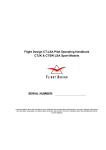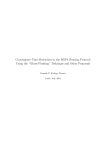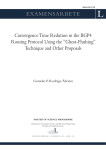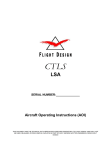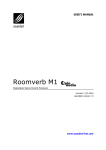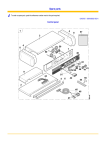Download Service Manual - Delta
Transcript
Service Manual Version: 22.12.1999 Flight Design International Sielminger Str. 65 D-70771 LeinfeldenEchterdingen www.flightdesign.com [email protected] Service manual Version 19.01.2000 1. Glider description ______________________________________________ 1 2. Transporting the GHOSTBUSTER__________________________________ 1 3. Set up and breakdown___________________________________________ 1 4. Flying Characteristic of the GHOSTBUSTER_________________________ 4 4.1. Launching ________________________________________________ 4 4.2. Flying the GHOSTBUSTER___________________________________ 4 4.3. Thermalling _______________________________________________ 5 4.4. Landing the GHOSTBUSTER _________________________________ 5 4.5. Winch towing _____________________________________________ 6 4.6. UL-towing ________________________________________________ 6 5. Maintenance __________________________________________________ 6 5.1. Adjustment of the control cables _______________________________ 6 5.2. Adjustment and function of the stopper rope ______________________ 7 5.3. Adjustment of the stopper rope ________________________________ 7 5.4. Replacement of the spoiler ropes ______________________________ 7 5.5. Checking the rope pulley _____________________________________ 7 5.6. Check of the ribs and rib connections ___________________________ 7 5.7. Rib No.8 and diagonal rib ____________________________________ 7 5.8. Main bolt and belt connection _________________________________ 7 5.9. Nose fitting _______________________________________________ 8 5.10. D - Spar _________________________________________________ 8 5.11. Rope connection at the ribs and the tip tube ______________________ 8 5.12. Rope connection at the flap ___________________________________ 8 5.13. Restoring rubber of the flap ___________________________________ 8 5.14. Sail _____________________________________________________ 8 6. Limits of usage ________________________________________________ 8 7. Technical data _________________________________________________ 9 8. DHV - classification _____________________________________________ 9 Apendix: set up pictures __________________________________________ 12 Service manual Version 19.01.2000 1. Glider description Footlaunchable Hang Glider FAI class 2 with cantilevered wings built primarily with carbon fibre. Note: The GHOSTBUSTER is certified only for solo flights. 2. Transporting the GHOSTBUSTER -by car As the spar is out of carbon fibre it is quite susceptible to punctual load. In the case of car top mounting a well-padded surface of sufficient length should be used to lay down the glider, e.g. a ladder with several padded rungs. If there are only two supporting points (roof rack) they should each be padded approx. 10 cm wide to distribute the load. It is recommendable to adjust the straps only as tight as necessary and not to place them on but next to another to get a bigger supporting area. The GHOSTBUSTER should be mounted with the control bar bracket (zipper on the bag) facing upwards. Apart from that we recommend to use a water proof bag to keep the GHOSTBUSTER dry and to protect it against salt (from icy roads). As the sandwich construction of the spar, the spoiler and the flaps absorb humidity, and if the GHOSTBUSTER gets wet anyhow it must be dried immediately to prevent it becoming mouldy and the metal parts to corrode. -by cable cars / railway / mountain railway Actually, the same applies for cable cars. Punctual load on the spar should be avoided. Some strips of foam material (e.g. isolating jacket) can be used to protect the glider. If nothing else is at hand your coat would serve well, too. 3. Set up and Breakdown Setup 1. Attach the control bar to the uprights. 2. Flip the GHOSTBUSTER upright and rest it on the control bar. Take care not to hold the glider at the nose turnbuckle as it is not made for bending moments. (pict. 1) 3. Turn the nose turnbuckle inside out. If the wings are spread out with the nose turnbuckle inside, the nose tube or the spar may be damaged. Take the nose and keel tubes and the diagonal ribs out of the D-spar (pict.2). 4. Spread the wings until the keel tube (without the lengthening piece) touches the ground (pict.3). Especially during the first times of setting the GHOSTBUSTER up this should be done carefully, for it is the only way to find out and to avoid mistakes in the order of set up and break down without damaging the glider. 5. Insert the diagonal ribs and push them until they reach the end of the socket and tension with the lever(pict. 4+5). Pay attention with the right and left side. 6. Link the sail with the keel. If necessary lift the spar a bit back in order to be able to hang up the hooks (middle of the sail) at the corresponding fitting at the keel (pict. 6) then zip up the top and the bottom zipper. (pict. 7) 7. The ribs should fall back into the sail. Service manual Version 19.01.2000 page 1 from 15 8. Now you have to insert the very outside rib into the corresponding fixture in the spar (pict. 8). Afterwards fix the sail with the loops at the ribs: Open the “Velcro“ strap at the trailing edge, clap out the ribs and tighten them securing the bottom and the upper sail loop around the notched end of the rib(pict. 9+10). Should you notice that one rib is not already clapped out, do it first. Get into the sail with your hand at the opened end of the “Velcro“ and help it. 9. Spread the wings all the way it is possible. Make sure that the trailing edge is smooth. Especially after an inspection where the “Velcro“ had to be opened completely, it may happen that the sail is uneven. If this is the case, the “Velcro“ linking top and bottom sail has to be removed and fastened once more after having finished with point 11. (pict. 11) 10. Hang up the nose turnbuckle at the bolt (pict. 12) and tighten while pushing the nose somewhat carefully backside down to the keel tube (pict. 13), after completely in position secure it with the quick pin. 11. Now fix the following points: rear end of the keel tube, front wire, nose tube and nose cone (pict. 14+15) 12. Push the bolt of the spoiler lever through the hole in the spoiler and secure the safety pin, after that fix the “Velcro“ ( pict. 16+17). 13. Insert the flap pin in the fourth rib trailing edge hole. Open the security pin of the second axle of the flap and hold it open. Position all axles taking care that they are between the flap tracks in each rib. Insert and secure the second axle trough the white guide in the third rib, now the flap can stand by it’s own. At the root of the flap near the keel, open the pulling hook and fix it in the top of the metal trail, after that insert the end of the rod bearing into the hole of the sail hooks and secure it with the lock pin. (pict. 18, 19, 20, 21 +22). Afterwards insert the quick pin at the trailing edge of the flap. With the second flap you proceed the same way. Important: After fixing each flap, put your finger at the quick pin block and perform a flap retraction test. This is important to be sure that the flap track is clear of the battens ropes and that the flap is not jammed under the ribs. 14. Fix the wing tip fairings. The easiest way is fitting the nose of the fairing and then adjusting the rear part.(pict. 23) 15. Now thread both the flap ropes through the clamps at the base tube and check the flap operation again. Pull each rope to be sure that the operating cables are working fine inside the glider. Pay attention to only operate one cable when the other is totally loose. 15. Fix the control cables of the spoiler and don’t forget to fix the security ring in the base tube quick pin (pict. 24). 16. Pull the flap rope for approx. 11 cm for a 15º flap deflection for take-off. Check before every launching: _ Repeated check of all links of the set up glider (safety rings and split-pins etc.) _ Make sure the flaps are fully functional (check all positions, as well as the ribs in all of the seven joining angles). _ Examine the spoilers’ deflection by moving the trapeze (about 80º deflection). _ The very outside rib (R8) should be positioned between diagonal rib and the rib positioned next to it. Make sure that the two metal pins of the rib ends are inserted at the PVC inserts at the spar wall (pict. 9). Breakdown Service manual Version 19.01.2000 page 2 from 15 Breakdown of the GHOSTBUSTER is simply the reverse of the set up procedure. But make sure you observe the following points: _ Detach the spoiler wire before you fold the wings in. _ The wing tip fairing, the flap and spoiler have to be removed before releasing the nose fitting _ Make sure you fold the sail in the area of the spar link the way it can not damage the zipper when folding in the spars (Pull the top sail up and fold the bottom sail in). At the zipper the upper sail should not be laid down between the spars. The zipper has to be fold once whereas the pusher of the zipper has to be pushed to the trailing edge. _ When dismantling the spoiler, be careful that the spoiler lever does not spring back against the rib. _ Make sure you pack all extra parts in the bag the way no damages may be caused by your car’s rack, the straps or any other mechanical influence upon the glider. NOTE: _ Never leave the diagonal ribs in position with the leading edge laying in the ground whilst the sail is not fixed at them. The sail prevents an outward movement that in extreme cases could damage the tip area. _ Never loosen or tighten the glider before removing the end of the keel. You can damage your turnbuckle otherwise. _ When setting the glider up or breaking it down make sure the spar is staying firmly without any rear end of a rib scraping the ground. _ You should only zip up or unzip the sail when the nose fitting is released. 4. Flying Characteristic of the GHOSTBUSTER 4.1. Launching When holding the GHOSTBUSTER it has a slightly tail heavy static balance. After the very first steps for take off it gets immediately stable in a favourable take off angle of attack. It is recommendable to test this characteristic on a plane surface before your very first flight. Due to the extreme effectiveness of the spoiler the wings can easily be maintained stable even at gusty winds. Nevertheless, for your own security you should test this characteristic on a plane surface in order to get used to the glider´s reactions. The position of the flaps when launching has proven to be good at approx. 15º. You will get this position when tightening the flap rope by about 11cm. < 11 cm > Apart from that the launching corresponds to conventional gliders. 4.2. Flying the GHOSTBUSTER The GHOSTBUSTER is controlled by weight shift, as it is the case with conventional gliders. However, due to the fact that it’s not really the body that is shifted but the control bar, which moves to the opposite direction, controlling the GHOSTBUSTER requires is much less effort. The artificial feel when initiating or ending a turn is, therefore, clearly less than with conventional gliders. The GHOSTBUSTER is stable at all axes, therefore it can be controlled smoothly. The easiest way is by moving Service manual Version 19.01.2000 page 3 from 15 your body as long as necessary to the desired side of the control bar till the glider begins to turn. Due to the aerodynamic control elements, the spoilers, there is no improved manoeuvrability of the glider by giving control pulses. Any additional deflection of the spoiler simply causes an undesirable flow resistance. When end-scale deflected, the spoilers have a high yawing moment. This is an advantage when quickly changing direction e.g. when thermalling. At high speed the end-scale deflected spoiler has to big yaw inputs. Specially when flying in strong thermal lift and turbulence you can induce an undesirable yawing movement by reciprocal end-scale deflection. This, however, will immediately end when you stop giving pulses. Service manual Version 19.01.2000 page 4 from 15 Speed at which a reduced spoiler deflection is recommendable: >65 km/h at 55º (flap) >80 km/h at any flap configuration (control bar positioned at your belly) In order to control trimming speed it is recommendable to fly with a speed meter, especially during the very first flights. It is important to never leave the flaps at 0 . The retracing mechanism is so built that a big slack occurs at this position. If you would fly at high speeds with them loose then a vibration will occur. In the extended position the flaps activating cords must always have tension. If the pilot for some reason wants to fly with small flap angles he must remember pulling a bit just to give the system a tension. There are no special guidelines for the retracted flap position, the GHOSTBUSTER flies very pleasantly in this configuration also, enabling the pilot to check the intensity of thermals without having releasing it. Pay attention to only operate one flap cable when the other is totally loose. 4.3. Thermalling A flap position of 15º when cruising has proven to be good due to a high manoeuvrability and a low minimum speed. Heavier pilots can find that increasing a bit the flap angles improves thermal performances. When flying in wide areas of lift or in strong turbulence it is recommendable to fly with a small flap deflection and a low rolling manoeuvrability. Here you’ll get the best sink rate performance. The best glide occurs at speeds around 50 km/h and a retracted flap. 4.4. Landing the GHOSTBUSTER For landing, the flaps should always be fully deflected. This is the best way to obtain the lowest stall speed and less performance, which is favourable at landing. With the flaps fully deflected the gliders L/D is still 10:1 while flying at trim speed. Only while accelerating the L/D drops until 5:1. So the easiest way to regulate the glide path is to deflect the flap completely and to vary the speed. It is recommendable, especially during the first landings, to apply the flap for landing already during the approach and in a sufficient height of more than 50 m and to fly a long final. The window for pushing the bar out is long. The final flare is similar to conventional gliders, except the fact that, due to the flaps fully deflected, the glider doesn’t have the tendency to transform speed in climb rate when pushing out the bar. Service manual Version 19.01.2000 page 5 from 15 NOTE: Although it is very easy to land the GHOSTBUSTER you should not do it without wheels or skids. 4.5. Winch towing The best way to tow the GHOSTBUSTER is with a flap position of 15º. This position enables you to control your speed better than with a smaller flap position. 4.6. UL-towing With calm the GHOSTBUSTER should be launched at a flap position of 15º due to low stall speed. Otherwise a smaller flap position is advantageous as the trimming speed can be adjusted to the speed of the UL and therefore the directional stability increases. Compared with a conventional glider it can happen that the control bar has to be pushed in order to reduce speed. 5. Maintenance The GHOSTBUSTER is mostly made out of fibre reinforced material. On the contrary to aluminium and steel this material has another type of fracture. Damages caused on most metal material can be seen by its going e.g. out of shape. However, dynamic forces can lead to hardly recognisable cracks also on metal material. A damage on fibre reinforced material is usually not assessable by remaining distortion. Other measures must be taken to detect damages, for example by controlling the stiffness of those points of hard tension, if there is any distortion or by checking if there is a delamination of the laminate or sandwich (with GFC noticeable, with CFC noticeable only through stiffness testing). For these reasons you should bring your glider for a check to an GHOSTBUSTER dealer, he is specialised to detect such damages. A first inspection by a dealer should be done after approx. 200 flying hours or at least after 24 months. However, till then it is vital to do the following checks yourself. Should there be any uncertainty do not hesitate in contacting the producer or your GHOSTBUSTER dealer. 5.1. Adjustment of the control cables The control cables are adjusted ex works, in order to move the control bar towards each side by 5-10 mm. However, check it always before every launching! The easiest way to do so is to lift the GHOSTBUSTER a little bit at its nose with one hand and to shift the control bare with the other hand to the right and the left. After the first flights the knots get tighter and the protection of the Dyneema rope stretches. Hereby your control gets a slight allowance. This, however, has no effect on your safety, but it should be adjusted if the allowance is more than 20 mm on each side, since you get a more direct handling on the ground and when flying. The following methods to adjust the control rope have proven to be the best: With the set up glider the “Velcro“ at the sail is opened at rib 4, 5 and 6. Now you can get into the sail from the trailing edge. In order to slacken the spoiler rope, the spoiler rib should be turned inside and the wing should be close to the ground. Now the rope can be tightened. By hanging up the spoiler rib and moving the wing up and down you can check, if it is duly adjusted. The spoilers have to deflect one after the other. The allowance of the spoiler rope at the trapeze should be checked, too. After Service manual Version 19.01.2000 page 6 from 15 having done all this, make sure that the knot is duly tightened by two half turns and a final knot and that all ribs as well as the “Velcro“ are fixed. After having adjusted the spoiler rope the stopper rope has to be adjusted, too, as described below. It can be done after having the glider set up or after the flight. 5.2. Adjustment and function of the stopper rope The spoiler rope has a stopper to reduce the effects of a bad landing, on the spoiler rib and lever during which the trapeze can be shifted crosswise. This stopper is a additional link between the steel rope and the spar. 5.3. Adjustment of the stopper rope When pulling the spoiler rope, the spoiler lever should be movable by 80º. In this position the spoiler rope has to be tight. Check it by moving the spoiler lever manually, while still pulling the spoiler rope. The tension of the spoiler rope should slacken at the lever. If the tension remains the stopper rope has to be shortened. In case the stopper rope is too short, the spoiler deflection will be limited and will have a negative effect on the roll ratio (pict. 30). Make sure, too, the stopper rope and the spoiler rope are not twisted. Should this be the case, the steel rope on the pulley has to be adjusted correspondingly. Check this after every 50 hours or every 20 flights when setting it up! 5.4. Replacement of the spoiler ropes Make sure that the spoiler ropes are replaced after approx. 200 hours, after 2 years or immediately after showing signs of wear (after wear is noticeable). 5.5. Checking the rope pulley Check regularly if the rollers are worn out. They have to be easy rotating and the rope should not be able to drop out of the roller by itself, to avoid the rope becoming stuck on the side (check every 50 hours of flight). 5.6. Check of the ribs and rib connections Ribs can be checked visually and mechanically. A defect or weak part on the laminate may be determined by pressing the surface with your thumb and forefinger. Another sign is a cracking sound when bringing pressure on it. The link between the rib tubes and the spar has to be checked duly, too. Weak points on the rib connections can be determined by moving the rib end up and down when being turned outside (load _ 0.50N). This way you can find out a possible fraction at the link between spar and connecting plates. Rib no. 7 at which the spoiler lever is fixed should be checked with extra care as well as the tying of the link for the spoiler lever. About every 50 hours and after every increased load the ribs should be checked. 5.7. Rib No. 8 and diagonal rib Should the end of the wing strive the ground at landing it is essentially to check the tip tube and the very outside rib. 5.8. Main bolt and belt connection The main pin as well as the belt connection are made out of a high-strength aviation alloy. To avoid corrosion those parts are nickel-plated. As the layer may be slightly Service manual Version 19.01.2000 page 7 from 15 damaged by mechanical influences, those parts should be wiped with a greased cloth, especially after the glider becoming wet. After becoming frequently wet the main bolts should be lubricated since they serve as a link. 5.9. Nose fitting After hard landings or tightening/loosening the glider with the keel extension in position, check for the proper functioning of the forks levers. They should run smoothly without touching each others surface. 5.10. D - Spar In case the D-spar might have suffered punctual loading as for example by setting it up in rocky sites or by (handling malpractice) or improper transport, those areas should be examined whether they are damaged or not. The nose can be checked by pressing the thumb on the sandwich where a weak point can be detected. However, this applies only for those parts of the nose which are not in the area of the spar belt or the loop connections. The spar belts are situated above and below the spar web as well as approx. 1,5m from the nose loop to the outside wing. If you detect any damage visually or mechanically, take your glider to the next GHOSTBUSTER dealer. He is able to tell whether the spar can be repaired or whether it has to be exchanged. The same applies for extreme punctual load on the spar during improper transport or after a crash with a breach of the nose tube although a damage had not been detected on the first sight. 5.11. Rope connection at the ribs and the tip tube Ribs and tip tubes are fixed with 2 mm Dyneema rope. Should you notice that theropes tension is not proper (by showing folds on the sail) you can adjust them yourself correspondingly. This may occur especially after the first flights. A damaged rope is to be replaced in any case immediately. In this context you have to pay special attention to the connection at rib no.7 and the diagonal rib. 5.12. Rope connections at the flap At the link to the Quick Pin the Dyneema rope is exposed to high mechanical loads. Here and at any other point the cladding should not show signs of wear. Check: every 10 hours. 5.13. Restoring bungee of the flap Should the flap refuse to move back to its end at the keel tube you’ll have to replace the restoring bungee. 5.14. Sail After extreme usage all seams, loops and ribbons should be examined. The zipper should be easy going. For a long life of your sail we recommend to store the glider dry and to avoid exposing it to ultraviolet rays more than necessary. 6. Limits of usage upper speed limit at a flap position of retracted - 15º upper speed limit at a flap position of 55º Service manual Version 19.01.2000 80 km/h 70 km/h page 8 from 15 maximum certified safe load maximum launching weight 7. +4g 90 - 153 kg Technical data Span Area (flap in-out) Flap deflection relative to the keel tube Aspect Ratio (flap in-out) Weight 8. 12,9 m 12,60 m_ - 13,50 m_ 0-55º 13,2 – 12,3 38 kg Classification DHV certification number Classification Max. take-off weight / number of seats Microlight tow Winch tow Double surface Number of battens In-flight trimming devices Type of uprights Base bar Special features MZL 01-357-99 3E 90 kg - 153 kg / 1 Yes Yes approx. 100 % 14/ Flaps Profiled speed bar briefing mandatory; cantilever rigid wing made of composite materials; Dacron sail; yaw-roll control through spoilers activated by shifting the base-bar; inboard retracting flap DHV Certification Test Flight Report NOTE: Marks ranges from 1 = best to 6 = worst GROUND HANDLING AND TAKE-OFF Static balance Aerodynamic balance Take-off speed Flaps 15 degrees Little tail heavy Neutral Low LEVEL FLIGHT V min (kph) V max (kph) Control bar pressure at 60 kph Control bar pressure at 80 kph Directional stability (yawing) Flaps 55 degrees 30 > 80 Low low-medium No yaw oscillations Service manual Version 19.01.2000 Flaps 0 degrees 35 > 80 low low No yaw oscillations 2 3 page 9 from 15 HANDLING IN TURNS Effort to enter turns Effort to exit turns Roll rate when increasing bank Roll rate when reducing bank Bank circling at Vmin. sink STALL BEHAVIOUR Straight flight, control bar slowly forward Straight flight, control bar quickly forward In turn, control bar slowly forward In turn, control bar quickly forward Provoked spin LANDING Glide out distance Point of flare V-range to flare Effort of flare Flaps 55 degrees Low Low average-long average-long slightly increasing average-long slightly increasing Flaps 0 degrees stable deep-stall Flaps 55 degrees stable deep-stall pitches down softly pitches down softly stable turn deep-stall stable turn deep-stall pitches down pitches down not possible not possible Flaps 55 degrees short easy to find average average ADDITIONAL SAFETY RELATED REMARKS 1 Service manual Version 19.01.2000 Flaps 0 degrees low low average-long 2-3 3 2 In extreme conditions is possible to induce spins and therefore they should be avoided. A briefing concerning set-up and flight is mandatory. 2 page 10 from 15 Service manual Version 19.01.2000 3 4 5 6 7 8 9 10 page 11 from 15 Service manual Version 19.01.2000 11 12 13 14 15 16 17 18 page 12 from 15 Service manual Version 19.01.2000 19 20 21 22 23 24 page 13 from 15 Service manual Version 19.01.2000 page 14 from 15
















